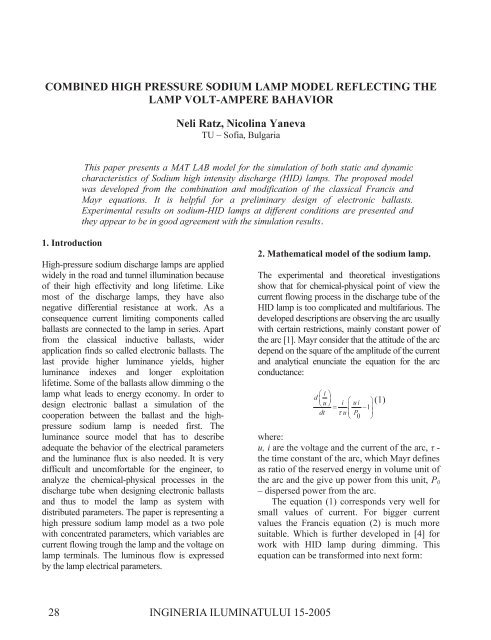Ingineria Iluminatului - Journal of Lighting Engineering - Prof. Florin ...
Ingineria Iluminatului - Journal of Lighting Engineering - Prof. Florin ...
Ingineria Iluminatului - Journal of Lighting Engineering - Prof. Florin ...
Create successful ePaper yourself
Turn your PDF publications into a flip-book with our unique Google optimized e-Paper software.
COMBINED HIGH PRESSURE SODIUM LAMP MODEL REFLECTING THE<br />
LAMP VOLT-AMPERE BAHAVIOR<br />
1. Introduction<br />
28<br />
Neli Ratz, Nicolina Yaneva<br />
TU – S<strong>of</strong>ia, Bulgaria<br />
This paper presents a MAT LAB model for the simulation <strong>of</strong> both static and dynamic<br />
characteristics <strong>of</strong> Sodium high intensity discharge (HID) lamps. The proposed model<br />
was developed from the combination and modification <strong>of</strong> the classical Francis and<br />
Mayr equations. It is helpful for a preliminary design <strong>of</strong> electronic ballasts.<br />
Experimental results on sodium-HID lamps at different conditions are presented and<br />
they appear to be in good agreement with the simulation results.<br />
High-pressure sodium discharge lamps are applied<br />
widely in the road and tunnel illumination because<br />
<strong>of</strong> their high effectivity and long lifetime. Like<br />
most <strong>of</strong> the discharge lamps, they have also<br />
negative differential resistance at work. As a<br />
consequence current limiting components called<br />
ballasts are connected to the lamp in series. Apart<br />
from the classical inductive ballasts, wider<br />
application finds so called electronic ballasts. The<br />
last provide higher luminance yields, higher<br />
luminance indexes and longer exploitation<br />
lifetime. Some <strong>of</strong> the ballasts allow dimming o the<br />
lamp what leads to energy economy. In order to<br />
design electronic ballast a simulation <strong>of</strong> the<br />
cooperation between the ballast and the highpressure<br />
sodium lamp is needed first. The<br />
luminance source model that has to describe<br />
adequate the behavior <strong>of</strong> the electrical parameters<br />
and the luminance flux is also needed. It is very<br />
difficult and uncomfortable for the engineer, to<br />
analyze the chemical-physical processes in the<br />
discharge tube when designing electronic ballasts<br />
and thus to model the lamp as system with<br />
distributed parameters. The paper is representing a<br />
high pressure sodium lamp model as a two pole<br />
with concentrated parameters, which variables are<br />
current flowing trough the lamp and the voltage on<br />
lamp terminals. The luminous flow is expressed<br />
by the lamp electrical parameters.<br />
INGINERIA ILUMINATULUI 15-2005<br />
2. Mathematical model <strong>of</strong> the sodium lamp.<br />
The experimental and theoretical investigations<br />
show that for chemical-physical point <strong>of</strong> view the<br />
current flowing process in the discharge tube <strong>of</strong> the<br />
HID lamp is too complicated and multifarious. The<br />
developed descriptions are observing the arc usually<br />
with certain restrictions, mainly constant power <strong>of</strong><br />
the arc [1]. Mayr consider that the attitude <strong>of</strong> the arc<br />
depend on the square <strong>of</strong> the amplitude <strong>of</strong> the current<br />
and analytical enunciate the equation for the arc<br />
conductance:<br />
⎛ i ⎞<br />
d ⎜ ⎟<br />
u i ⎛ ui ⎞<br />
⎝ ⎠<br />
= ⎜ −1⎟<br />
dt τ u ⎜ P ⎟<br />
⎝ 0 ⎠<br />
(1)<br />
where:<br />
u, i are the voltage and the current <strong>of</strong> the arc, τ -<br />
the time constant <strong>of</strong> the arc, which Mayr defines<br />
as ratio <strong>of</strong> the reserved energy in volume unit <strong>of</strong><br />
the arc and the give up power from this unit, P0<br />
– dispersed power from the arc.<br />
The equation (1) corresponds very well for<br />
small values <strong>of</strong> current. For bigger current<br />
values the Francis equation (2) is much more<br />
suitable. Which is further developed in [4] for<br />
work with HID lamp during dimming. This<br />
equation can be transformed into next form:
















